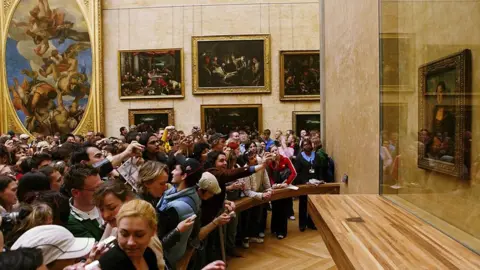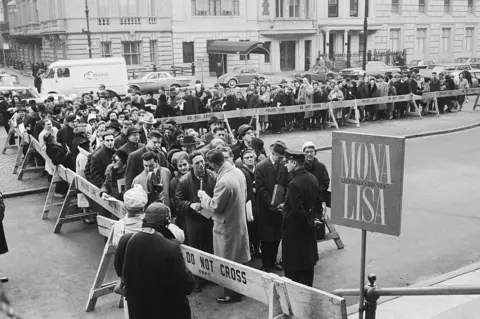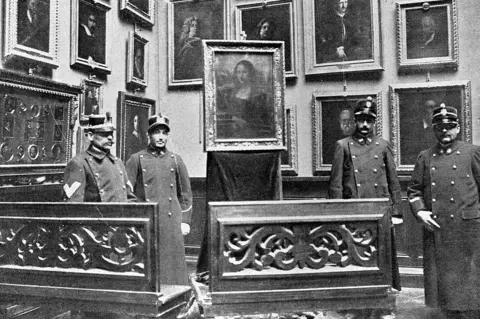Mona Lisa is moving - what does it take to keep her safe?
 Getty Images
Getty ImagesShe's one of the world's most recognisable faces, with a smile that's been printed on mugs, bags and T-shirts across the globe. But she's only left her country a handful of times, and has stayed in the same room for 14 years.
We're talking about Mona Lisa, Leonardo da Vinci's Renaissance masterpiece that has been on display in the same room since 2005.
But it's being moved overnight on Tuesday from its usual home, the Salle des États in the Louvre in Paris to another room in the same museum. From Wednesday until October, it will be displayed in the Galerie Médicis, so that the Salle des États can be renovated.
Although the painting isn't going very far, moving it is still a delicate operation.
Why is Mona Lisa being moved?
The Louvre has been undergoing massive renovations for the past five years. The museum says more than 34,000 sq m (366,000 sq ft) has been renovated so far, including 17,579 sq m of gallery space.
It's currently the turn of the Salle des États.
Unsurprisingly, given its famous resident, the Salle des États is the Louvre's most-visited room - which means that it's suffered a fair bit of wear and tear in the 14 years since its last major refurbishment.

You might also like to read:

Work on the room actually began in January, but the renovators have so far been able to work around Mona Lisa. Now, they need to carry out work on the wall behind the painting.
Another painting in the same room, Veronese's Wedding Feast at Cana, is going to stay in a protective case for the entire time the renovations are carried out.
The Galerie Médicis, where Mona Lisa is moving, is one of the museum's largest rooms.
Will it be hard to move Mona Lisa?
The short answer is "yes" - but the long answer is, "not that much harder than most artworks".
Catriona Pearson, exhibitions manager at the University of Oxford's Ashmolean Museum, tells BBC News: "The risk doesn't change regardless of the value, we always move things in the same way - which is to say, very, very carefully!"
She explains that gallery workers try to limit how much they move an artwork, and keep the number of people handling it to a minimum if they can, because "the more movement it goes through, the higher the risk is".
And although Louvre director Jean-Luc Martinez told AFP that the Galerie Médicis was only "100 paces" away from the Salle des États, there are still risks.
People pose one big risk. This is why gallery workers try to arrange these moves for a time of day when there are fewer visitors. The Louvre, for example, chose to move Mona Lisa in the evening, after the museum had closed.
 Getty Images
Getty ImagesThen, the workers do a trial run with a piece of wood that is roughly the same size and shape as the painting.
When moving a painting within a museum, Ms Pearson says, "you look at your route in advance, and perhaps do a walk-through with whoever is going to be moving the object".
"This is something we do sometimes if it's a particularly large painting, and we're not sure if it will fit through all the doors and lifts," she says.
"We'll mock-up with plywood the shape of the object and do a walk-through to check, because sometimes angles going around corners and things are tighter than you'd expect. You can measure them, but until you try to walk the object round there, you're not going to find out."
If you're moving an artwork abroad, Ms Pearson says, it's a bit more complicated.
"For moving from one museum to another, and from one country to another, there's a whole new set of risks," she says. "You need to make sure that the object is going to be packed correctly using crates."
You then need to decide how you want the object to be transported - by road or by air, for example - based on how fragile the artwork is.
 Getty Images
Getty ImagesWhen the artwork arrives, it needs to get used to its new environment - especially if it's travelled overseas. So the artwork will be left in its crate to acclimatise.
Altogether, this can take up to a year to plan for.
Has Mona Lisa ever been sent abroad?
Yes, but only a handful of times in recent history.
The painting last left France in 1974, when it was loaned to Russia and to Japan.
Some 11 years earlier it was loaned to Washington DC's National Gallery and New York's Metropolitan Museum of Art - also known as the Met - for two blockbuster exhibitions that have gone down in history for how popular they were.
According to the Met, then-French culture minister André Malraux was approached by First Lady Jackie Kennedy during an official trip to Washington in 1962, who asked him if the US could display Mona Lisa.
He was open to the idea, but many in France protested, arguing that the journey across the Atlantic could damage the artwork.
 Getty Images
Getty ImagesFortunately, when it made the journey the following year, it survived - and saw tens of thousands of people queuing for hours in freezing cold temperatures just to catch a glimpse.
Back in 1911, the painting was stolen from the Louvre by Vincenzo Perugia, an Italian gallery worker who thought it should be taken back to Italy. It eventually re-emerged in Florence two years later.
Perhaps, some speculate, this is why the Louvre rejected a request from the city of Florence for a loan of the work in 2013.
